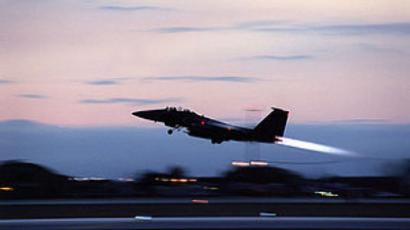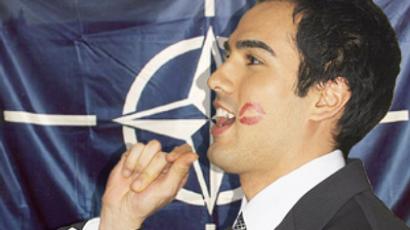Russia's new security strategy: sleeker and stronger
Dmitry Medvedev has signed the final version of Russia’s new security strategy. While it focuses on economic development and people’s welfare, the document has some harsh words for US policy and NATO.
In the overview of national defense, the strategy names as a threat the “policy of some leading countries, aimed at military supremacy” by building up nuclear and conventional strategic arms, unilateral development of anti-ballistic missile defense and militarization of space. The policy “may trigger a new arms race,” the document warns.
While Russia is not going to waste money on stockpiling its arsenals, it will “act in a least costly manner to keep party with the United States of America in terms of strategic weapons,” to counter the ABM system and take into account the global strike concept in the US military doctrine. The latter refers to the stated ability of US forces to strike at any target in the world in a matter of half a day.
In practical terms the new strategy means that Russia will keep its nuclear forces at a high degree of readiness, while continuing with its military reform, which will see Russian troop numbers reduced and transformed into an instrument of solving regional conflicts.
“What is special about this document is the fact that for the first time Russia gave such a clear description of its national interests. The content of the Strategy makes it clear that Moscow will continue a conflict-free foreign policy and will not allow it to be drawn into an arms race.”Sergey Seliverstov,
Security expert, deputy director of the Institute of Economics At the same time the document, which was published on the national Security Council’s website, says Russia’s relations with the US have a key influence on the global situation and calls on building a strategic partnership based on mutual interests. Russia will seek confidence-building, strategic disarmament, the non-proliferation of weapons of mass destruction, joint anti-terrorism efforts and partnership in solving regional conflicts.
The new national strategy dismisses NATO’s expansion plans and ‘attempts to assume global functions’ as unacceptable to Russia. It says the relations with the North-Atlantic alliance will be determined by its willingness to “take into account Russia’s lawful interests,” “to respect international law” and its reform, which will help the bloc find a new mission and humanitarian functions.
“Regional centers of power will have more and more importance in the modern world, while such terms as ‘superpower’ will become things of the past. With this multipolarity, which our Foreign Ministry has been waiting for so long, emerging, we really have no right to not become one of those regional powers.”Mikhail Margelov,
Chairman of Russian Parliament’s Commission of international relations Competition for natural resources is bound to grow while the benefits of globalization are distributed unfairly among nations, which will increase tension. According to the new strategy, key regions of conflict will be the energy-rich Middle East, the Arctic, the Caspian Sea and Central Asia. The tension may escalate into open wars near the borders of Russia and its allies.
The document says Russia will modernize its border troops to be prepared for possible military conflicts and to prevent crimes like trafficking of drugs, weapons and human beings, smuggling and poaching. Borders with Kazakhstan, Ukraine, Georgia and Azerbaijan as well as regions of the Arctic, the Caspian Sea and the Far East require special attention.
“What’s important – the Strategy is based on the fundamental assumption of the interdependence of stable development of the nation and its national security. Providing decent living conditions in Russia is a priority on par with traditional areas of defense capability and national security. It’s the major feature of the Strategy, reflecting its social and socio-political direction.”Nikolay Patrushev,
Secretary of Russia’s Security Council
On the economic side, the main challenges are the export nature of Russia’s industry, its overt dependence on global markets, labor inefficiency, vulnerable financial system and corruption. The document suggests focusing on state-private partnership in key industries, support high-tech projects, facilitate trade for Russian producers and fight corruption. The goal is to become the fifth country in the world in terms of GDP.
Among other threats to Russia’s national security the strategy names: global financial crises, which “may have a devastating effect comparable to the large-scale use of military force”; terrorism and extremism; social injustice; epidemics and socially dangerous decease like tuberculosis; a lack of domestically produced food and medicine; the industrial impact on Russia’s environment, and cybercrime.
“With the increase of the number of NATO members, with Washington trying to get a foothold in the regions of Russia’s traditional interests, and with the threat of the spreading of extremist and terrorist ideas, only by strengthening national military potential will Russia be able to stand its ground in the world arena and defend its territorial integrity.”Viktor Zavarzin,
Chairman of the Russian Parliament’s Committee on defense
National Security Strategy 2020
The document outlining Russia’s policy in security until 2020 replaces the 1997 paper, which was outdated, according to many experts. The work on it started in September 2008, shortly after the conflict in South Ossetia, and was finished by the end of March this year. Some media speculated that the signing of the document was postponed until Dmitry Medvedev’s meeting with Barack Obama in April and said the ‘anti-American’ statements in it may have been changed after it.
One of the key differences of the new strategy is the list of indicators, which are to show how secure Russia is. These include the unemployment level, inflation, the disproportion of people’s incomes, national debt and others.














